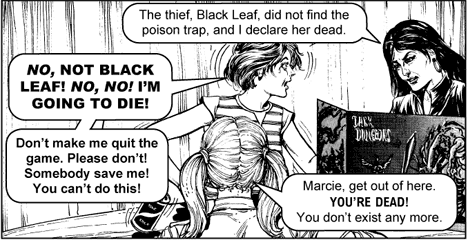 In 1984, fundamentalist Christian evangelist Jack Chick published a religious tract titled Dark Dungeons. This illustrated tract, like many “Chick tracts,” is structured as a one-page comic. It tells the story of two teenage girls, Debbie and Marcie, both of whom are avid Dungeons & Dragons players.
In 1984, fundamentalist Christian evangelist Jack Chick published a religious tract titled Dark Dungeons. This illustrated tract, like many “Chick tracts,” is structured as a one-page comic. It tells the story of two teenage girls, Debbie and Marcie, both of whom are avid Dungeons & Dragons players.
The tract opens with Debbie, Marcie, and several other teenagers gathered around a table playing D&D. In the second panel, Marcie’s character, a thief named Black Leaf, is poisoned by an unseen trap and dies. Marcie, visibly distraught by her character’s sudden death, pleads for a fellow adventurer to come to her aid, but to no avail. After the game, Debbie is approached by the mysterious older Dungeon Master, Ms. Frost, who says that now Debbie’s cleric, Elfstar, has “been raised to the eighth level,” it is time she learned how to really cast spells. Debbie, incredulous, asks breathlessly if Ms. Frost will teach her how to have the real power.
In subsequent panels, Debbie — or rather, Elfstar — is inducted into a coven as a priestess and witch, casts her first “mind bondage” spell on her father (who, no doubt fearing for his daughter’s immortal soul, attempted to stop her playing D&D), and becomes so enthralled by her growing power that she ignores Marcie in her time of need. Marcie, unable to cope with life without the escapism of her alter ego Black Leaf, takes her own life by hanging herself in her bedroom.
Debbie’s seemingly inexorable decline is halted by the sudden introduction of a wholesome young man named Mike who, upon discovering Debbie in a state of grief over her friend’s suicide, patiently explains that Jesus is the only way to win the battle of spiritual warfare in which she is currently embroiled. Mike takes Debbie to a “meeting,” led by a man bearing a remarkable resemblance to Fox News’ John Stossel who, after reading passages from the Bible, casts out the evil spirits residing within Debbie. The tract concludes with Debbie burning all of her “occult material,” including her D&D manuals, and giving her life to Jesus.
Chick’s company, Chick Publications, claims to have printed more than 750 million tracts since Chick self-published his first in 1960, but Dark Dungeons is by far the most popular. The comic is most definitely a product of its time, yet it has lost little of its appeal during the past thirty years. The tract has been adapted into a low-budget film due to be released later this month, following a Kickstarter campaign launched by J.R. Ralls, a self-described “typical middle-class middle manager” from Oregon. Ralls felt compelled to adapt Dark Dungeons into a film after winning $1,000 in the state lottery, and sought Chick Publications’ permission to make the film. Ralls genuinely believes that table-top role playing games such as D&D “can make you gain real life magical abilities” and that “if you gain a high enough level, you’ll be invited to join a secret cult,” according to the film’s Kickstarter page.
What makes Dark Dungeons so dangerous isn’t its depiction of the supposed perils of playing table-top role-playing games, or even the misogynistic rhetoric that pervades the tract (which is perfectly exemplified by Debbie’s induction into the coven, a sect aligned with the Temple of Diana, which is a branch of feminist Wiccan witchcraft first established in the United States by Zsuzsanna Emese Mokcsay in the 1970s). The real reason that Dark Dungeons is so alarming is that it perpetuates a frankly ridiculous notion of the occult that exists solely in the realm of popular culture and the fevered imagination of the religious right.
America’s guilty fascination with the occult began in the late 1960s. The publication of Ira Levin’s wildly popular Rosemary’s Baby in 1967, Roman Polanski’s equally successful big-screen adaptation of the book in 1968, and the ritualistic murder of Polanski’s wife, Sharon Tate, by Charles Manson’s “family” the following year all contributed to an unprecedented obsession with cabalistic supernaturalism. However, this preoccupation with the occult would not reach its apex until a decade later, with the disappearance of Michigan State University student, James Dallas Egbert III — an incident that later came to be known as the beginning of “the Satanic Panic.”
In addition to being a gifted student, Egbert was also widely known on campus for being a keen D&D player. When Egbert disappeared from his dorm room on the night of April 15, 1979, rumors began to circulate that he had ventured into the utility tunnels beneath the university to live out a real-life version of his table-top fantasies. In reality, Egbert — who was coping with drug addiction and suffering from depression at the time of his disappearance — had entered the college’s subterranean system of tunnels with the intent of taking his own life due to the pressure he faced to excel academically. Although Egbert finally succeeded in committing suicide by shooting himself in his apartment in 1980, his third such attempt, the true circumstances surrounding the incident would not come to light until four years later, when private investigator William Dear published his nonfiction book, The Dungeon Master: The Disappearance of James Dallas Egbert III.
By the time Dear’s book hit the shelves, fears of suburban covens and ritualistic child abuse had already been keeping American parents up at night for years, due in large part to the publication of the now-discredited biography, Michelle Remembers, in 1980. Written by Canadian psychiatrist Lawrence Pazder and his former patient Michelle Smith, whom Pazder later married, the book — which is considered the first on the subject of satanic ritual abuse — detailed Smith’s falsified accounts of the abuse she claimed to have suffered at the hands of her mother and other members of a Satanic cult in Victoria, British Columbia, when she was five years old.
In the years following the publication of Michelle Remembers, the media’s appetite for lurid stories about the occult was insatiable, and added to the widespread public fear of the imaginary threat of satanic ritual abuse. The high-profile suicide of Virginian teen Irving Pulling in 1982 — another casualty blamed on the dark power of D&D — Tipper Gore and the Parents Music Resource Center’s crusade against the supposed evils of rock music in 1985, and the thousands of lawsuits filed over the alleged ritualistic sexual abuse of children throughout the 1980s further contributed to the spread of misconceptions about Satanism and the occult. Although the panic surrounding satanic ritual abuse has been largely dismissed as the overwrought hysteria it was in the years since, public misconceptions of Satanism have endured.
Satanism is alive and well in America — but not in the way most people think.
True Satanists don’t sacrifice children in bizarre arcane rituals. They don’t gather in darkened enclaves to summon forth the evil gods spoken of in forgotten tomes, nor do they drink the blood of virgins from ornate chalices. In fact, most Satanists don’t worship the devil in literal terms at all, instead regarding Satan as a figurative representation of the rejection of any authority that presumes to restrict the freedoms and liberties of the individual.
The tenets of modern Satanism were first established when renowned occultist Anton Szandor LaVey founded the Church of Satan on April 30, 1966. LaVey chose this date carefully, as April 30 is also known as Walpurgisnacht, a night when, according to German folklore, witches would gather at the summit of the Brocken, the highest peak of the Harz Mountains in northern Germany, to await the coming of spring, a ritual described in Goethe’s Faust.
The Satanic Temple, on the other gnarled hand, first emerged in late 2012 and officially incorporated in January of this year (a statement intended to directly oppose many religious organizations’ tax-exempt status), considers itself a more proactive, civic-minded and liberal alternative to what some Satanists see as the more conservative Libertarian leanings of the Church of Satan.
The Church of Satan has remained notoriously insular since its conception. Outside the Satanic subculture, little is known about the Church’s activities, and it remains fiercely committed to avoiding actions that could be interpreted as self-promotional, a position that is contrasted sharply by that of The Satanic Temple. Peter H. Gilmore, current leader and Magus of the Church of Satan, has dismissed The Satanic Temple as self-serving, and even went as far to publicly deride its efforts to raise awareness of important civic issues within the context of Satanism as “sketch comedy as activism.” Regardless of the Church’s obvious disdain for the Temple and its activities, there remains a substantial disconnect between perceptions of Satanism as a religion and the Temple’s mission to protest the erosion of Americans’ civil liberties at the hands of the conservative political and religious establishment.
Few people are more keenly aware of this schism than Doug Mesner, aka Lucien Greaves, spokesman for The Satanic Temple. I recently met with Mesner for lunch — ironically, on a Sunday afternoon — to discuss the statue of Baphomet, the Temple’s recently launched informed consent awareness campaign, and Satanism’s enduring image problem. Dressed entirely in black, with the exception of a gray T-shirt underneath his hooded sweatshirt, Mesner was polite, reserved and instantly likeable.
“I came into this really expecting the worst,” Mesner says. “I felt like it was suicide, taking on the face of The Satanic Temple. That being said, I feel like it’s been much better than I expected. For the most part, I really can’t complain.”
Initially, Mesner’s true identity was a mystery, with Lucien Greaves serving as the very public face of The Satanic Temple. However, Mesner was unmasked following the publication of an exclusive story written by Shane Bugbee in Vice that revealed Mesner’s identity — a gesture of good will that Mesner says Bugbee exploited for his own personal gain.
“That was a friend of mine at the time who I gave that exclusive to,” Mesner says of Bugbee. “He actually had nothing to do with the formational ideas of any of this. He was just somebody I knew, and I tried to give him a place in the project.”
Mesner told me that the Temple’s relationship with Bugbee turned sour shortly after the “Pink Mass,” a highly publicized ceremony that was performed over the grave of Catherine Idalette Johnstone, mother of the late Fred Phelps, Jr., former head of the reviled Westboro Baptist Church. The ritual, which took place in July last year and over which Mesner officiated, was a protest of the hate group’s plans to picket the funerals of victims of the Boston Marathon bombing. The symbolic ceremony was also conducted with the intention of “turning” Johnstone gay in the afterlife.
“With the Pink Mass, I wrote the press release. [Bugbee] simply emailed it to different outlets,” Mesner says. “He insisted in more payments afterwards. You know, we paid him, didn’t even look over what he was doing or check his quality of work or whatever, and then he insisted on more payment. We just kind of split, without any foul words to one another, but I felt quite clearly we couldn’t work with him again. Now he’s going around saying that he laid the foundations for the monument and all this crap. He’s even gone as far to say that I work for the CIA and these kinds of things. It was really disappointing. I knew him for years. He’s really gone off the rails.”
Mesner is certainly no stranger to the hysteria and delusions that contributed to the Satanic Panic. Growing up, Mesner observed the phenomenon unfold firsthand, and wrote about it extensively long before he become The Satanic Temple’s spokesman.
“I grew up in that environment,” Mesner says. “I grew up in the Midwest, and I was very aware of the Geraldo specials and the daytime TV talk show specials where they were talking about infant sacrifice and this roving occult mafia murdering and going absolutely insane in the background of our communities. That, more than anything, drew me to it; to figure out what the truth of it was. It wasn’t until later that I began questioning these ideas. When you’re a little kid and you see these things on TV, you think they’re vetted by authoritative characters and there’s truth to it. Later on, you remember these ridiculous stories. I read Satantic material because I thought there’s just no way that LaVey’s bible advocates for or lays out this criminal framework. I spoke with a lot of the conspiracy theorists who helped construct the Satanic Panic, and got an idea of where that came from, and really began to see how harmful it was, how harmful their witch hunt was. I’ve spoken to people who were very deeply affected by it, who came out of that.”
In addition to raising the profile of Satanism as a religion — albeit what Mesner describes as an “atheistic religious construct” — the Temple is currently engaged in a range of high-profile campaigns to draw attention to the hypocrisy of the religious and political right. One such initiative that has gained widespread media exposure is the Temple’s plan to install a statue of Baphomet, a deity that many Knights Templar were burned at the stake for worshiping in the 14th century and a staple of Satanic iconography, alongside the monument to the Ten Commandments on the grounds of the Oklahoma State Capitol.
Predictably, the Temple’s plan has drawn the ire of Christians nationwide and Oklahoman lawmakers. Alex Weintz, a spokesman for Oklahoma Governor Mary Fallin, told Fox News that, “There will never be a satanic monument on the grounds of the Oklahoma State Capitol, and the suggestion that there might be is absurd.” Although the chances of the sculpture taking its intended place alongside the Ten Commandments on the lawn of the Oklahoma statehouse are slim, the statue has reignited a vigorous nationwide debate about the Sooner State’s decision to ignore the Establishment and Free Exercise clauses of the First Amendment of the Constitution — a decision that has also attracted the attention of the American Civil Liberties Union, which has filed suit against the state.
However, the statue of Baphomet is just one project in which The Satanic Temple is currently engaged. Following the Supreme Court’s recent ruling that arts and crafts retail outlet Hobby Lobby could legally deny certain medications that its Christian owners consider abortifacients to employees under its healthcare plans, the Temple launched a campaign to provide faith-based exemptions to so-called “informed consent” laws for women seeking abortions. The Temple, along with many other organizations, believes that these laws are little more than a thinly veiled attempt to dissuade women from pursuing abortions using purposefully misleading and medically inaccurate information, guilt, and scare tactics.
Some of the Temple’s critics have accused the organization of capitalizing on the extensive media coverage that the Supreme Court’s ruling in the Hobby Lobby case has attracted. However, according to Mesner, the timing of the campaign was serendipitous, rather than calculated.
“We were working on these things before the Hobby Lobby ruling,” Mesner says. “You see in the ruling that they were allowed to describe certain pharmaceutical contraceptives as abortifacients when they’re not. I feel that gave us further latitude to say that, well, this informed consent material isn’t scientifically valid. It’s medically illegitimate. Furthermore, given the Hobby Lobby ruling, it doesn’t matter if they get a medical expert to say that it is. It’s our deeply held belief that it’s not. That’s good enough. What is encouraging, though, about the Hobby Lobby campaign is that we’ve been contacted by lawyers who are willing to work for us pro bono, which is extremely helpful.”
Mesner believes that the Supreme Court’s ruling in the Hobby Lobby case, and the constitutional validity of the Temple’s almost inevitable legal challenge, could ultimately prove to be a Pandora’s box for the religious right.
“I feel that, one way or the other, it will be a favorable outcome from a broad legal perspective,” Mesner says. “I would personally like to see this tested in court, and I feel like we have quite a few days in court coming up. We still have the monument, of course, and I don’t see that not going to court, and that could, in all likelihood, become a Supreme Court case.”
The monument, which is a modern interpretation of the deity, stands seven feet tall and bears many of the distinguishing features associated with Baphomet in classical occult imagery. Baphomet has the horned head of a goat, from the crown of which a flame protrudes, and a human torso. Two large wings are partially folded behind the statue, and a caduceus — a staff entwined by twin serpents first carried by Hermes in Greek mythology — rests on Baphomet’s lap. The statue sits beneath the inverted pentagram, completing the aesthetic of the traditional Sigil of Baphomet, and two children, a boy and a girl, gaze upon the statue adoringly from either side.
“I love it. I can’t believe what an excellent job the artist has done,” Mesner says of the sculpture. “He quit his job and just dove into this full-time — at cost — because it’s something that he truly believes in. It’s great that we get that kind of support from people, because it takes a lot of time, money and resources to make these things happen. It’s going to be finished in September.”
Although the media coverage of the monument has been invaluable in promoting the Temple’s campaign and raising its profile in general, the project is not without its detractors — including some from within the Satanic subculture itself.
“In its purest form, it’s supposed to have breasts,” Mesner explains. “People are complaining that the breasts were taken away, but that was kind of an executive decision that I came to. The artist was advocating for taking away the breasts. I felt it should have the breasts, but that we should find a way to cover them, or else we were giving Oklahoma this opportunity to say, ‘We cannot have bare breasts out.’ I am convinced, still, that is the issue they would take. They would be so happy to concentrate on something other than the issue we’re showing to them. So, ultimately, the artist was showing me different renderings and incarnations, and the breasts just weren’t working, so we went with the male chest.”
Whether or not the monument to Baphomet has breasts is among the least of the organization’s concerns. Satanism, generally speaking, has something of an image problem, and the media and popular culture are only partially responsible for the stubbornly enduring misconceptions of Satanism. Several recent high-profile murders have garnered widespread media attention and rekindled Americans’ fear of the occult due to claims of connections to devil worship by the perpetrators. In Mesner’s opinion, the Satanic Panic never truly died — it just went underground.
“Paranoid ideas always have their market,” Mesner says. “It appeals to a certain psychology of people, they’re always there, but some of those ideas change shape. I think the reason you still see the Satanic Panic still going strong in the therapeutic subset is that it’s evolutionary. They say we’re defending pedophiles. That’s such a horrible claim to make against somebody — that you promote pedophilia. Everybody shuts up, and a lot of people are afraid to take them to task for that very reason. That’s how these people tend to survive. It also makes everything very cut-and-dry for people. It’s a tidy narrative. They think they’re confronting the cold, hard facts. That reason alone, that they’re able to look at something so horrific and realize that it’s real, contributes to its validity, you know? Like, who would want to believe such a thing? In kind of this perverse way, it’s a more manageable narrative. It gives them an absolute bad guy to deal with. If we could just take it away, everything will be okay.”
Katie Nichols of Knoxville, Tennessee, confessed to murdering her own mother to a news crew during a live broadcast covering the incident in February. Nichols claimed that her mother was the leader of a Satanic cult, that she had been “casting Satantic spells” on her for days prior to the attack, and that she intended to kill Nichols’ daughter.
Miranda Barbour — the so-called “Craigslist killer” who has been charged with the 2013 murder of forty-two-year-old Troy LaFerrara — told police that she had joined a Satanic cult in her native Alaska at the age of twelve. Since her arrest, Barbour claims to have killed at least twenty-two other people, and reports that she has admitted to killing as many as one hundred victims have been circulated by the media, despite the lack of any supporting evidence and the specious nature of her claims.
Jose Reyes, a seventeen-year-old from Houston, Texas, was charged with the murder of fifteen-year-old Corriann Cervantes earlier this year, along with an unnamed sixteen-year-old accomplice. Reyes told police that the murder was part of a Satanic ritual, and that Cervantes was killed to fulfill a pact with the devil. Investigators told local news outlets that “religious cult items” were discovered at the scene of the crime, and that an inverted crucifix had been carved into Cervantes’ stomach — details that serve no public interest, sensationalize the tragic killing of a fifteen-year-old girl, and capitalize on her family’s grief.
“It’s discouraging because they’ll run these stories, and the conspiracy theorists will always refer back to those stories,” Mesner says. “There aren’t really corrective stories printed. You don’t see stories that say, ‘Well, we now know for damn sure that Barbour had no connections to any Satanic cult’ or whatever. I mean, you can never prove a negative anyway, but just the same, they’ve promoted this idea and now it’s out there forever.”
Aside from the brutal and shocking nature of their crimes, what these killers share is not a bond of blood forged in any archaic ritual, a common worship of the lord of darkness, or even a history of mental illness, despite the media’s enthusiasm to draw such conclusions. The unifying theme in these murders is the rejection of personal responsibility — a position that adherents to the true ideals of Satanism would find abhorrent and morally repugnant. These killers, like many of those who came before them, have sought to justify their violent actions by claiming they were manipulated by malevolent external forces, rather than acknowledge their own depravity. Though some, such as Katie Nichols, may indeed be mentally ill, she and other killers like her are not the victims of wicked spirits or demonic possession, but rather a woefully inadequate healthcare system that fails millions of people every day.
“There are still people who work within the mental health field who promote this idea of a Satanic conspiracy,” Mesner says. “The Satanic Panic is still alive, it’s still ruining people’s lives. If you look at an organization like the ISSTD — the International Society for the Study of Trauma and Dissociation — it’s taken seriously. As a mental health organization, it studies dissociation, and that’s kind of code for multiple personality disorder. Their membership is still just amok with people who spread the most crass delusions you can believe. Life-ruining delusions. I’ve gotten into it with some of these therapists over stuff like that. Sometimes, I feel as though they’re just as much victims of this delusion as anybody else. I hold accountable, at the very end of it, the APA [American Psychiatric Association] and the different licensing boards that have really shown no motivation to question the licensing standing of the conspiracy theorists within mental health. To me, that’s a big issue that I want to take on through The Satanic Temple.”
It remains to be seen whether the Temple will be able to transcend the stereotypes and misinformation that have plagued contemporary Satanism since LaVey founded the Church of Satan in 1966. However, Mesner remains optimistic for the future of the Temple and its mission to undertake noble pursuits guided by individual will.
“I don’t even mind so much when people question our sincerity and authenticity, because we’re actually doing things, unlike LaVey’s Church. All they have is the credibility of people looking to them as the final word on Satanism,” Mesner says. “Us, we’re going to have to be reckoned with one way or the other because we’re pushing these issues. We’re going to take it to court. You can say we’re a farce all you want, but we’re going to get results one way or the other.”
This post may contain affiliate links.







